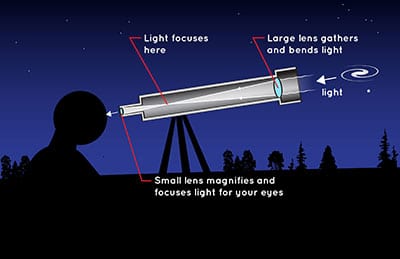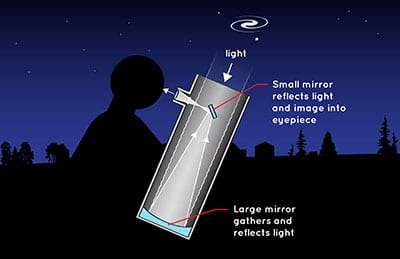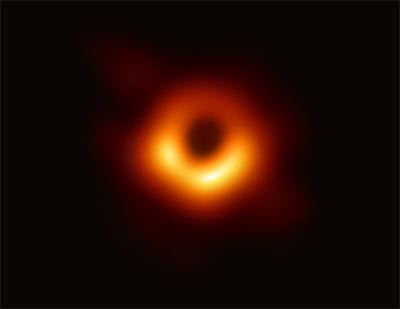Learning the Different Types of Telescopes: Beginner’s Guide
October 2th, 2019
by Andrea Lloyd
Interested in stargazing, but not knowing which types of telescopes work best for your hobby? Let’s find out today! Enjoy a bit of telescope history and a quick review on how light works!
In the early 1600s, two Dutch children explored a lens shop. Curiosity, a natural product of childhood, led them to look through the lenses Hans Lippershey had made. They peered through the glass, noticing how it could warp one’s view. Like young scientists, the children experimented with placing two lenses together. The result was you could see images brighter and larger.
Enter the Refractor Telescope
Noticing the children playing in his shop and taking the chance to mimic them, Lippershey peered through the glass lenses at the local church’s weather vain. Interested in how it appeared closer, the Dutch eyeglass maker invented the kijker or “looker” in Dutch. This 1608 invention is known today as the refracting telescope.
Light = Radiation
Sitting in a physics class, an in-depth understanding of a telescope would be given during an optics lecture. The chapters in the book would provide images of eyeballs, cameras, microscope, and telescopes—all behaving based on the principles of sight and behaviors of light. A fancier way of explaining that is the properties of transmission and deflection of radiation.

Similar to the ocean, electromagnetic radiation moves in oscillating waves. The waves are measured anywhere from meters (AM radio waves) to picometers (ultraviolet). The wavelengths give different types of radiation altered properties. X-rays, for example, can create a photo of our dense bones because our skeletons absorb the radiation. Our organs and other soft tissues allow the beams to pass through them. Visible light wavelengths appear as different colors, from longest wavelength to shortest: red, orange, yellow, green, blue, indigo, and violet.
Which Is the Best Telescope for Astrophotography This Year? - Astrophotography and stargazing are noble hobbies, which require specialized equipment and skills. Nevertheless, we are here to show you nine of the best telescopes for astrophotography on the market right now so you can make an educated choice.
A Quick Review of Light Behavior
Waves across the spectrum behave differently when encountering objects. What defines the behavior is both the wavelength of the electromagnetic wave and the composition of the object.
Reflection
Reflection is when light hits a smooth surface and bounces off, such as a mirror that reflects almost all visible light.
Absorption
Absorption occurs when the light hits molecules, causing them to vibrate and grow hotter, emitting thermal energy. Dark-colored objects absorb more light energy than other colors and radiate thermal energy. A hot summer day will leave black pavement absorbing light and radiating heat.
Diffraction
Diffraction is bending and spreading waves around an obstacle, like when light hits through the clouds after a rainy afternoon and separates into different wavelengths (colors) to form a rainbow.
Scatter
Scatter occurs when light bounces off an object in a variety of directions. The sky appears blue because of the shorter wavelengths being scattered by oxygen and nitrogen atoms in our atmosphere.
Refraction
Refraction bends light as it passes through a different transparent object. Light travels slower through water, and even slower through solids. Light waves will change directions as it is slowed to varying rates through a medium. When a straw is in a glass, the straw appears bent even though, in reality, it is
Optical Concepts Explained: How do Telescopes Work? - Have you ever wondered how do telescopes work? Today, we discuss optical concepts, magnification, optical instruments' tech specs, and other things that might interest you whenever you search for a hobbyist's or an educational telescope, binoculars, microscopes, and even magnifying glasses!
All of this—light, wavelengths, behaviors—connects back to the refracting kijker Lippershey invented. When the children peered through multiple lenses, they were refracting the light in such a way to bend the light to focus objects further, seeing clearer and closer than the naked eye could.
How Eyes and Telescopes Work
Eyes work through light reflected off of objects. Telescopes work through light reflected off of objects. Earlier, reflection was established… but how does it work in this context?


Reflector Telescopes – How Are they Different?
With reflecting telescopes, we replace the refracting with reflecting, and the lenses with curved mirrors. The primary mirror gathers the light and reflects it into a smaller mirror to reflect the image into the eyepiece.
9 Best Telescopes for Beginners | Reviews and Recommendations - Whether you have an established passion for astronomy and you want to move up to the next level or you just want to stargaze to understand what is up there, one of the best telescopes for beginners on this list will help you make your dreams come true!
Other Types of Telescopes
Optical telescopes, as described above, are two of the most common for amateur astronomers. In 1609, Galileo Galilei constructed a refracting telescope after hearing about the invention, making some of his most famous discoveries like Jupiter’s moons and sunspots. Sir Isaac Newton produced the first reflecting telescope in 1668, now known as Newtonian Telescopes, although scientists since Galileo’s time have been experimenting with the concept.
Professional astronomers use a range of telescopes to look at all kinds of to look across the electromagnetic spectrum: infrared telescopes, radio telescope, ultraviolet telescopes, x-ray telescopes, etc.

Conclusion
Telescopes help us reach galaxies beyond our own, whether it’s from our backyard or the observatory. There’s so much more to discover in the universe we live in and explore!
So what did we learn?
Want to learn more about types of telescopes and how they work? Check out our guides and telescope reviews, together with our latest news on space exploration and discoveries!



